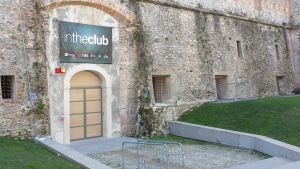There was a problem loading image 'images/edificimilitari/04_santatecla_11_cannone_su_molo_1875.jpg'
There was a problem loading image 'images/edificimilitari/04_santatecla_11_cannone_su_molo_1875.jpg'
There was a problem loading image 'images/edificimilitari/04_santatecla_26_nuova_sistemazione.jpg'
There was a problem loading image 'images/edificimilitari/04_santatecla_26_nuova_sistemazione.jpg'
From its construction until today
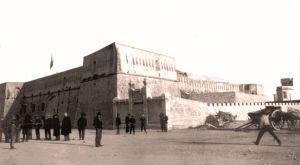 Its construction was ordered in the 18th century by the Republic of Genoa, following a popular uprising in Sanremo, which, after the war of Austrian succession, had not only imprisoned the commissioner of the Maritime Republic, Matteo Vinzoni, but also asked for annexation to the Kingdom of Sardinia. Genoa reacted to the insurrection with violence and, in order to intimidate the rebels with its artillery, decided to erect a great fort, still today a memory of the dramatic events suffered by our distant ancestors.
Its construction was ordered in the 18th century by the Republic of Genoa, following a popular uprising in Sanremo, which, after the war of Austrian succession, had not only imprisoned the commissioner of the Maritime Republic, Matteo Vinzoni, but also asked for annexation to the Kingdom of Sardinia. Genoa reacted to the insurrection with violence and, in order to intimidate the rebels with its artillery, decided to erect a great fort, still today a memory of the dramatic events suffered by our distant ancestors.
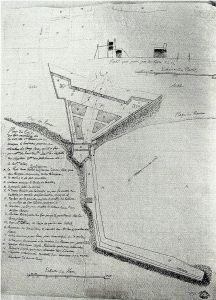 On the advice of the military engineer Giacomo De Sicre, the Republic decided that the fortification, one of the most admirable examples of eighteenth-century Ligurian military architecture, should be erected on the esplanade of Pian di Nave "using" - as Ferrari always rebuilds - "the pre-existing bastion on which the glorious flag of San Romolo was garrisoned by the sea breeze, knocking down thirteen of the houses that would have come to be of encumbrance when the fire mouths were pulled towards the town", and with them the ancient oratory of the confreres of San Mauro, the small monastic complex of Sant'Antonio and the chapel of San Rocco which was incorporated into the Fort.
On the advice of the military engineer Giacomo De Sicre, the Republic decided that the fortification, one of the most admirable examples of eighteenth-century Ligurian military architecture, should be erected on the esplanade of Pian di Nave "using" - as Ferrari always rebuilds - "the pre-existing bastion on which the glorious flag of San Romolo was garrisoned by the sea breeze, knocking down thirteen of the houses that would have come to be of encumbrance when the fire mouths were pulled towards the town", and with them the ancient oratory of the confreres of San Mauro, the small monastic complex of Sant'Antonio and the chapel of San Rocco which was incorporated into the Fort.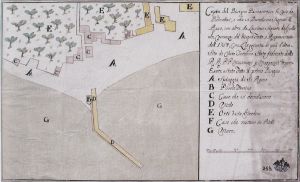 The construction works were directed by Gio Batta Montaldo Genovese, and began at the end of 1753, immediately meeting the opposition of the people of San Romolo, who did not want to collaborate. It was necessary to ship building materials from Civitavecchia and 200 workers from outside San Remo.
The construction works were directed by Gio Batta Montaldo Genovese, and began at the end of 1753, immediately meeting the opposition of the people of San Romolo, who did not want to collaborate. It was necessary to ship building materials from Civitavecchia and 200 workers from outside San Remo.
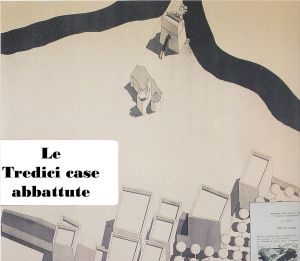 After the demolition of the thirteen houses in the Pian di Nave district, on 10th June 1754 the foundations were laid, and together with a relic of Saint Tecla, from which the name derives, the first stone of the Fort was laid on 6th July 1754 with a sung mass.
After the demolition of the thirteen houses in the Pian di Nave district, on 10th June 1754 the foundations were laid, and together with a relic of Saint Tecla, from which the name derives, the first stone of the Fort was laid on 6th July 1754 with a sung mass.
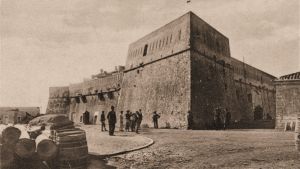 The ceremony was attended by a small crowd "with frowned faces" who watched in "silent regret" because of the destruction of the houses.
The ceremony was attended by a small crowd "with frowned faces" who watched in "silent regret" because of the destruction of the houses.
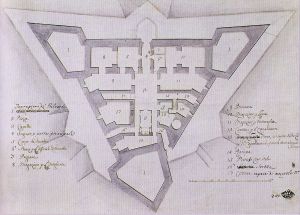
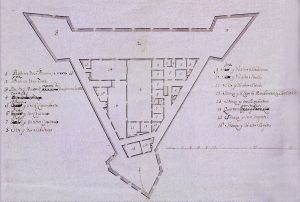 The people of San Remo, instead, deserted the ceremony and went in procession to the Hermitage of San Romolo to invoke the protection of the patron saint.
The people of San Remo, instead, deserted the ceremony and went in procession to the Hermitage of San Romolo to invoke the protection of the patron saint.
The governor Doria in retaliation closed the sacred `bauma', imprisoned the poor custodian and forced the clergy from that day to recite the prayer for the Republic, which was often and willingly forgotten.
The fort was completed at the end of March 1756 and handed over to the first garrison; in June the chapel was blessed, in July the cannons were placed against the rebel city, achieving the aim "to have there a brake and a bridle that would keep the people in awe so that they could no longer revolt".
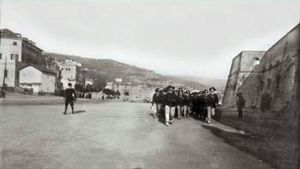
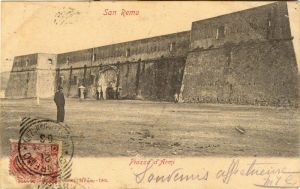 The fort of Santa Tecla (the patron saint of the caulkers, whom the construction works had forced to move away from their yard...), baptized obviously by the Genoese "di San Giorgio", was built on a triangular plan, with a bastion towards the sea and a horn work formed by two half-bastions, separated by a long curtain on which there were pieces of artillery threatening the city.
The fort of Santa Tecla (the patron saint of the caulkers, whom the construction works had forced to move away from their yard...), baptized obviously by the Genoese "di San Giorgio", was built on a triangular plan, with a bastion towards the sea and a horn work formed by two half-bastions, separated by a long curtain on which there were pieces of artillery threatening the city.
Inside, the ground floor was occupied by the chapel, the storerooms, the cistern and the commander's flat; while the first floor was used to house the lodgings of the soldiers and the workers, with the powder magazine in the ancient 16th century tower that had been incorporated into the fort, the commanders, the infantry and the warehouse. On the second floor were the lodgings for the two captains; bombers and artillerymen, a quarter for the soldiers, the storerooms and the batteries, two facing the land and one facing the sea. The fire potential of the fort was 16 large pieces of artillery from the front bastions and 5 smaller ones from the rear bastion. The construction had cost more than 100,000 lire, against the estimate of 70,000. It remained officially in use until the Napoleonic invasion of 1796, when the population, who felt liberated from the centuries-old yoke of the Republic of Genoa, demolished part of the ramparts, preventing rapid access to the pier.
It remained officially in use until the Napoleonic invasion of 1796, when the population, who felt liberated from the centuries-old yoke of the Republic of Genoa, demolished part of the ramparts, preventing rapid access to the pier.
The fort of Santa Tecla also played its role during the Napoleonic age, within the defence system entrusted to the coastal batteries located along the coast. In addition to the three cannons of the fort, one 36 mm and two 24 mm, a pair of 18 calibre cannons were placed at Capo Pino and another one at Madonna della Guardia.
The seven cannons ended their 'career' as bollards for the mooring of the ships along the west pier of the port.
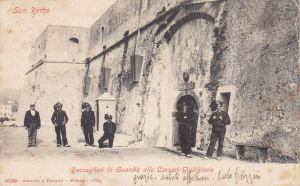
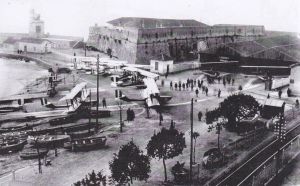 Starting from 1864 it was instead used as a district house. It remained a prison until 1997, with the exception of the three-year period 1915 - 1918 when it became a seaplane base.
Starting from 1864 it was instead used as a district house. It remained a prison until 1997, with the exception of the three-year period 1915 - 1918 when it became a seaplane base.
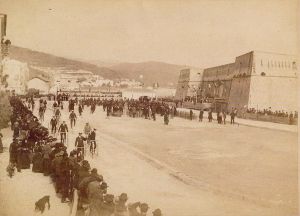
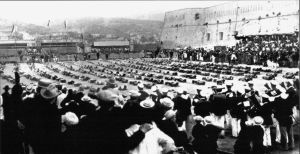 During the twenty years of Fascism, the clearing in front of the entrance to the Fort became the theatre of sporting events, celebrations and gymnastic essays.
During the twenty years of Fascism, the clearing in front of the entrance to the Fort became the theatre of sporting events, celebrations and gymnastic essays.
In that period a company of tourist seaplanes, the SITAR, started up in its vicinity, exploiting the existing Hangars. During the German occupation between 1943 and 1945 it was no longer a prison but used as an ammunition depot.
During the German occupation between 1943 and 1945 it was no longer a prison but used as an ammunition depot.
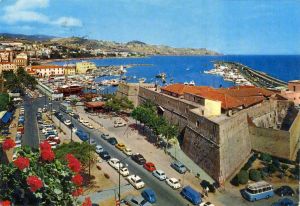
 Today the Fortress of Santa Tecla, after having been assigned for a period of time to the Superintendence for the Heritage Environmental and Architectural Old cells of Liguria and finally, is owned by the Municipality of Sanremo, which has allocated the
Today the Fortress of Santa Tecla, after having been assigned for a period of time to the Superintendence for the Heritage Environmental and Architectural Old cells of Liguria and finally, is owned by the Municipality of Sanremo, which has allocated the 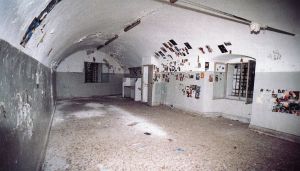 recovered and restored premises to exhibitions and events.
recovered and restored premises to exhibitions and events.
(Various sources elaborated by Roberto Monfroni; own photos and the WEB)





